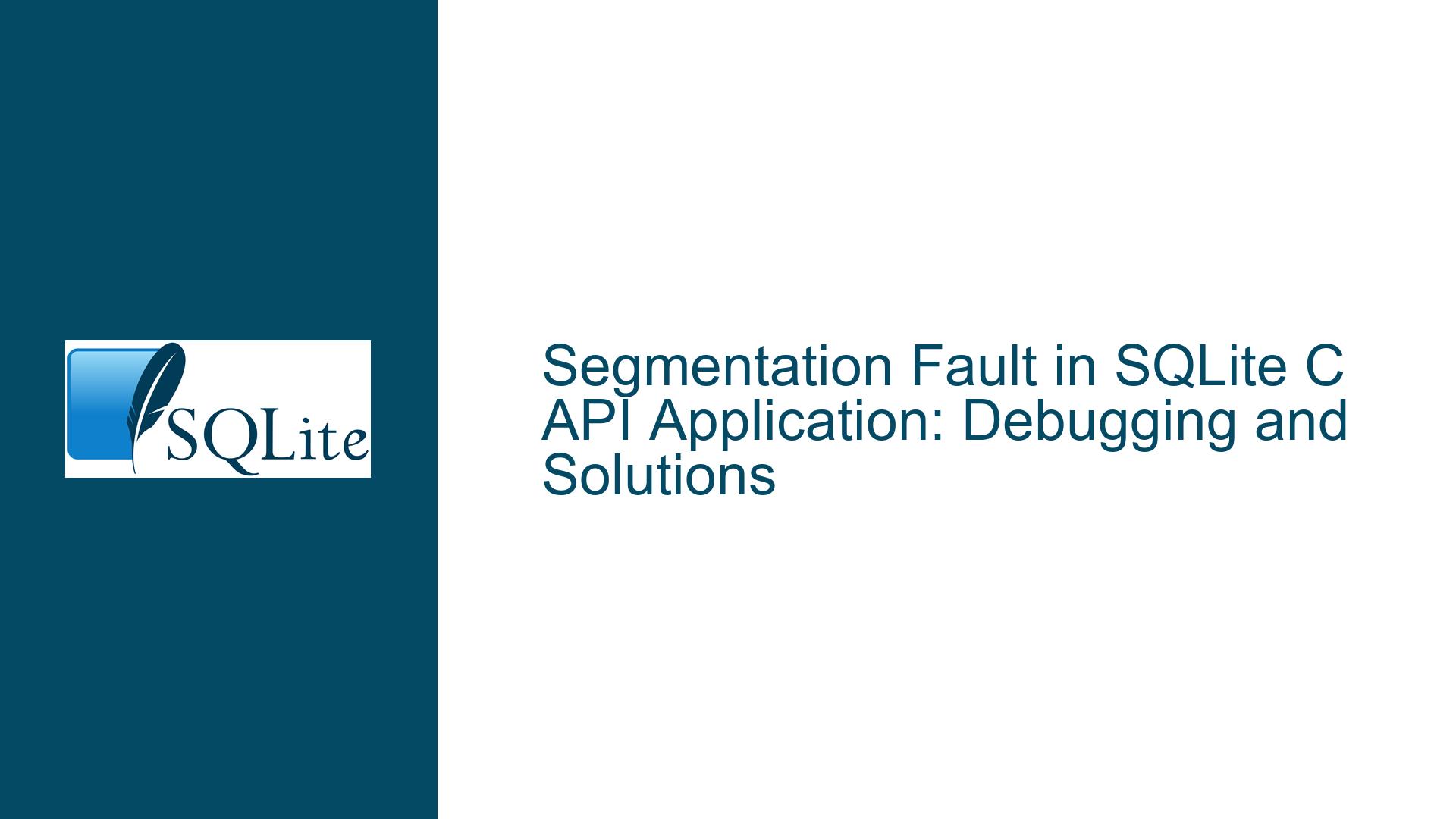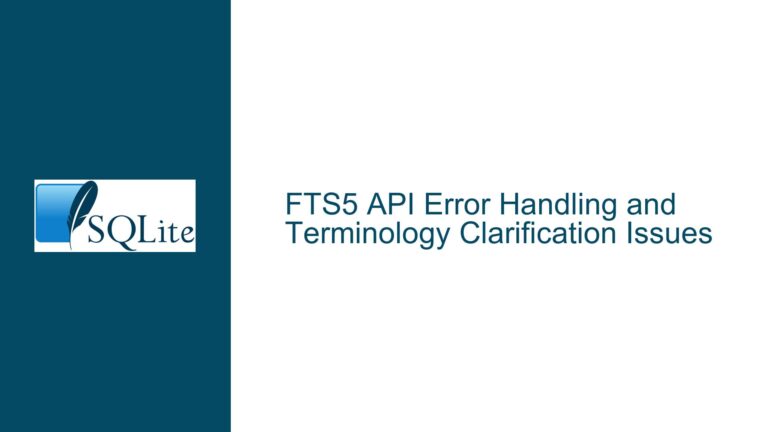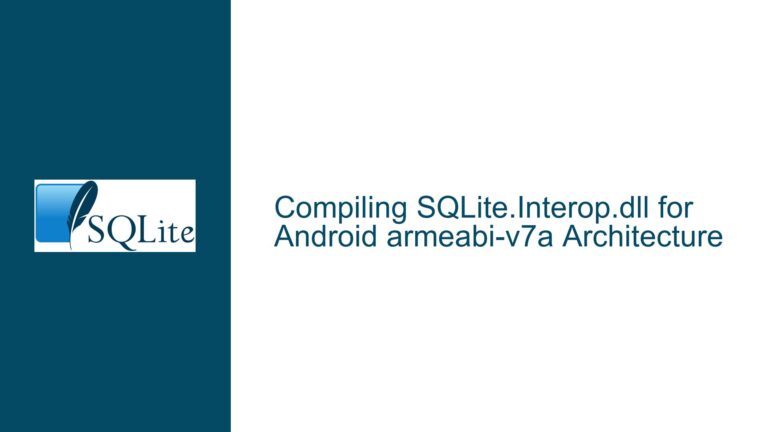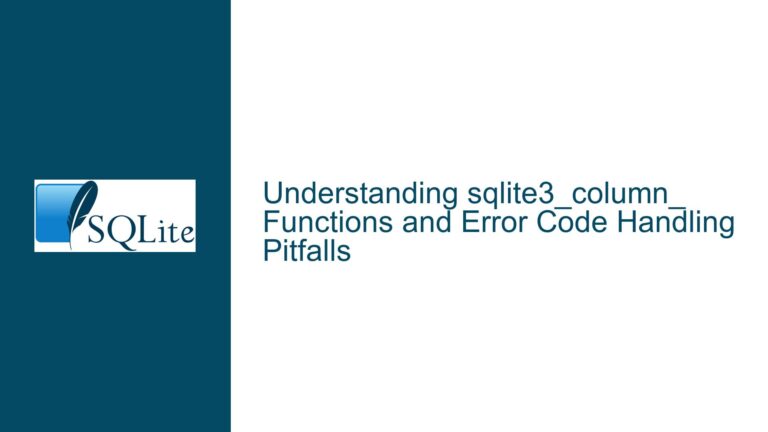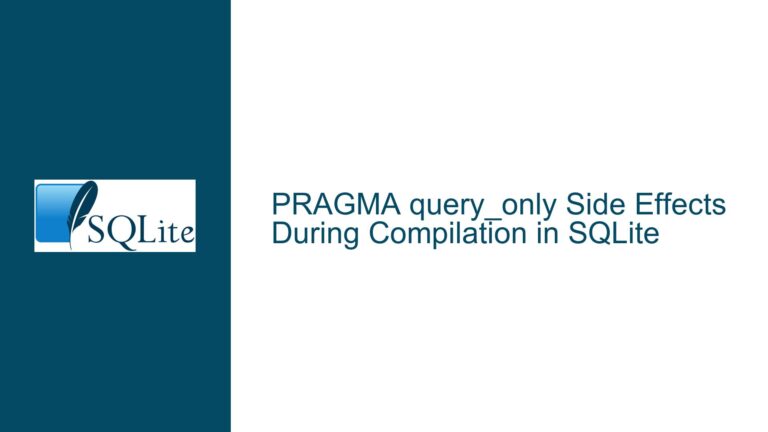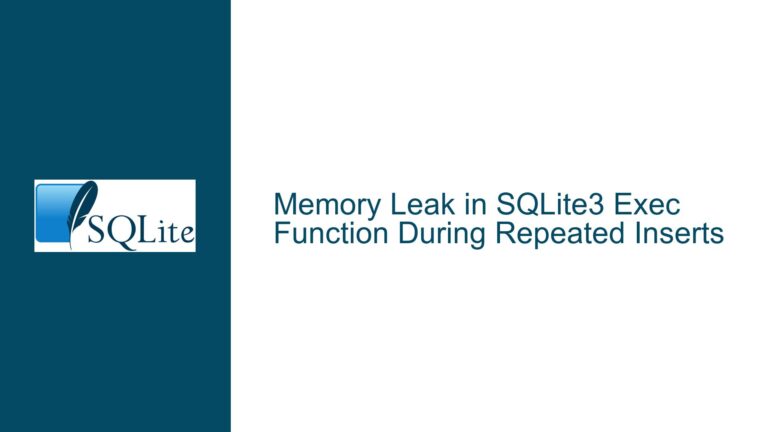Segmentation Fault in SQLite C API Application: Debugging and Solutions
SQLite C API Segmentation Fault During INSERT and SELECT Operations
The core issue revolves around an application using the SQLite C API that intermittently crashes with a segmentation fault (SEGV) during INSERT and SELECT operations. The segmentation fault manifests in two distinct stack traces: one during the execution of sqlite3ExprListDup (related to INSERT operations) and another during sqlite3WhereBegin (related to SELECT operations). The application is written in C++11, runs on macOS, and uses SQLite version 3.22.0. The database schema consists of a single table with six columns and four indices. The application is multi-threaded, with a singleton connector class managing database operations, including transactions, INSERTs, and SELECTs.
The segmentation fault is non-deterministic, making it difficult to reproduce consistently. The issue is further complicated by the application’s use of a wrapper around the SQLite C API, which handles database connections, transactions, and query execution. The wrapper employs mutex locks to ensure thread safety, but the singleton design restricts concurrent access to the database connection. The segmentation fault occurs despite these safeguards, suggesting deeper issues in memory management, SQLite API usage, or the interaction between the application and the SQLite library.
Heap Corruption and Improper SQLite API Usage
The segmentation fault is likely caused by heap corruption or improper usage of the SQLite C API. Heap corruption can occur due to memory misuse in the application, such as accessing freed memory, buffer overflows, or double-free errors. The SQLite library itself is highly deterministic and robust, so the fault is more likely rooted in the application’s interaction with the library or its memory management.
One potential cause is the misuse of the sqlite3_exec function, which is used for executing both INSERT and SELECT statements. This function compiles and executes all SQL statements in the provided string, which can lead to unexpected behavior if the SQL string contains multiple statements or is improperly formatted. Additionally, the application’s use of string parsing to determine whether a query is a SELECT or INSERT operation is fragile and error-prone. This approach can lead to incorrect query classification and improper handling of SQL statements.
Another possible cause is the improper handling of prepared statements. The application uses sqlite3_prepare_v2 to prepare SELECT statements but relies on sqlite3_exec for INSERT operations. This inconsistency can lead to memory leaks or corruption if the prepared statements are not finalized correctly or if the database connection is not managed properly. The singleton design of the connector class, while ensuring thread safety, may also introduce bottlenecks or race conditions if the database connection is accessed concurrently by multiple threads.
The multi-threaded nature of the application adds another layer of complexity. Although the connector class uses mutex locks to prevent concurrent access, there may still be race conditions or deadlocks if the locks are not implemented correctly. Additionally, the SQLite library is not inherently thread-safe, and improper handling of database connections or statements across threads can lead to segmentation faults.
Debugging Heap Corruption and Optimizing SQLite API Usage
To resolve the segmentation fault, the application’s memory management and SQLite API usage must be thoroughly debugged and optimized. The following steps outline a comprehensive approach to identifying and fixing the root cause of the issue.
Step 1: Debugging Heap Corruption
Heap corruption can be diagnosed using tools like Xcode Instruments on macOS. The application should be run under the "Allocations" and "Leaks" instruments to identify memory misuse, such as accessing freed memory, buffer overflows, or memory leaks. The "Zombies" instrument can also be used to detect accesses to deallocated objects.
If heap corruption is detected, the application’s memory management code should be reviewed for common issues, such as:
- Incorrect use of pointers or references.
- Buffer overflows or underflows.
- Double-free errors or accessing freed memory.
- Improper handling of dynamically allocated memory.
The SQLite library itself can also be a source of heap corruption if the application misuses its APIs. For example, failing to finalize prepared statements or improperly managing database connections can lead to memory leaks or corruption. The application should ensure that all prepared statements are finalized using sqlite3_finalize and that database connections are properly closed using sqlite3_close.
Step 2: Optimizing SQLite API Usage
The application’s use of the SQLite C API should be optimized to avoid common pitfalls and improve robustness. The following recommendations should be implemented:
Replace
sqlite3_execwith Prepared Statements: Thesqlite3_execfunction should be replaced with prepared statements for all SQL operations, including INSERTs. Prepared statements are more efficient and safer, as they allow for parameterized queries and better error handling. The application should usesqlite3_prepare_v2to prepare all SQL statements andsqlite3_stepto execute them. Prepared statements should be finalized usingsqlite3_finalizeafter execution.Use
sqlite3_column_countfor Query Classification: The application should usesqlite3_column_countto determine whether a query is a SELECT or INSERT operation, rather than relying on string parsing. This approach is more robust and avoids the pitfalls of string-based query classification. Ifsqlite3_column_countreturns zero, the query is non-fetching (e.g., INSERT, UPDATE); otherwise, it is a fetching query (e.g., SELECT).Implement Proper Error Handling: The application should implement comprehensive error handling for all SQLite API calls. This includes checking the return values of
sqlite3_prepare_v2,sqlite3_step, andsqlite3_finalizeand handling errors appropriately. Error messages should be logged or displayed to aid in debugging.Review Transaction Management: The application’s transaction management code should be reviewed to ensure that transactions are properly begun, committed, or rolled back. The
sqlite3_begin_transaction,sqlite3_commit, andsqlite3_rollbackfunctions should be used to manage transactions explicitly. The application should also handle transaction errors gracefully and ensure that transactions are not left open indefinitely.
Step 3: Enhancing Thread Safety
The application’s multi-threaded design requires careful handling of database connections and statements to ensure thread safety. The following steps should be taken to enhance thread safety:
Use Thread-Safe SQLite Configuration: The SQLite library should be compiled with thread-safe options enabled. This can be achieved by defining the
SQLITE_THREADSAFEmacro to 1 or 2 during compilation. Thread-safe configuration ensures that the SQLite library can handle concurrent access from multiple threads.Implement Connection Pooling: The singleton design of the connector class can be replaced with a connection pooling mechanism to allow concurrent access to the database. Connection pooling manages a pool of database connections that can be borrowed and returned by threads, reducing contention and improving performance.
Use Mutex Locks Consistently: The application should use mutex locks consistently to protect shared resources, such as database connections and prepared statements. Mutex locks should be acquired before accessing shared resources and released immediately after use to minimize contention.
Avoid Long-Running Transactions: Long-running transactions can lead to contention and deadlocks in multi-threaded applications. The application should ensure that transactions are kept as short as possible and that locks are released promptly after use.
Step 4: Upgrading SQLite and Testing
The application should be tested with the latest version of SQLite to ensure compatibility and take advantage of bug fixes and performance improvements. SQLite version 3.22.0, used in the application, is outdated, and upgrading to a newer version may resolve known issues.
After implementing the above steps, the application should be thoroughly tested to ensure that the segmentation fault is resolved. Testing should include stress testing with high concurrency and large datasets to identify any remaining issues.
Conclusion
The segmentation fault in the SQLite C API application is likely caused by heap corruption or improper usage of the SQLite API. By debugging heap corruption, optimizing SQLite API usage, enhancing thread safety, and upgrading SQLite, the issue can be resolved. The application’s memory management and SQLite interaction should be carefully reviewed and tested to ensure robustness and reliability. Implementing these steps will not only fix the segmentation fault but also improve the application’s performance and maintainability.
